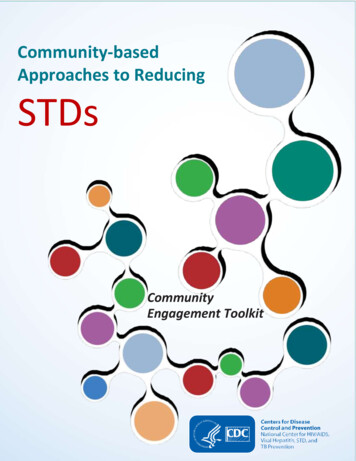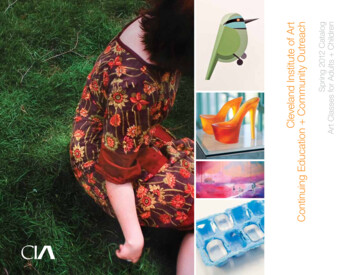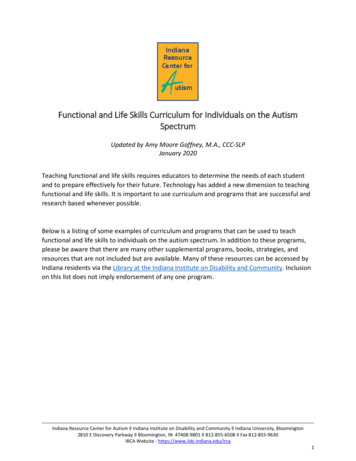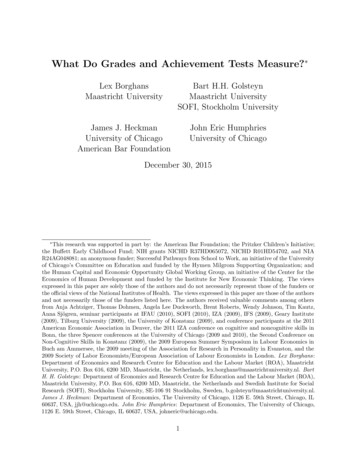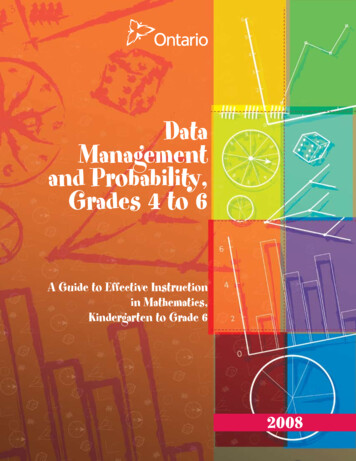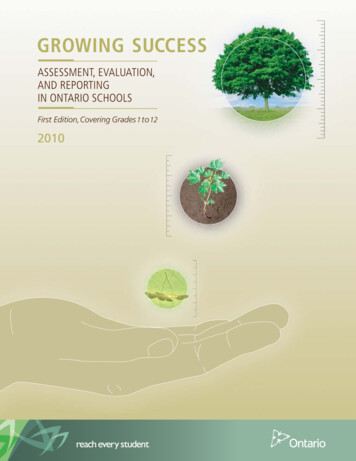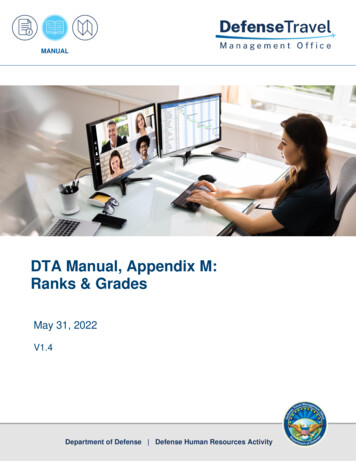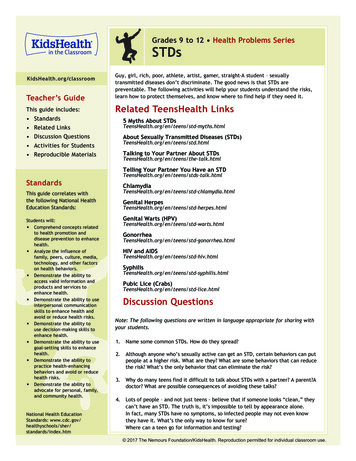
Transcription
Grades 9 to 12 Health Problems SeriesSTDsKidsHealth.org/classroomTeacher’s GuideThis guide includes:Guy, girl, rich, poor, athlete, artist, gamer, straight-A student – sexuallytransmitted diseases don’t discriminate. The good news is that STDs arepreventable. The following activities will help your students understand the risks,learn how to protect themselves, and know where to find help if they need it.Related TeensHealth Links Standards5 Myths About STDsTeensHealth.org/en/teens/std-myths.html Related Links Discussion QuestionsAbout Sexually Transmitted Diseases (STDs) Activities for StudentsTeensHealth.org/en/teens/std.html Reproducible MaterialsTalking to Your Partner About STDsTeensHealth.org/en/teens/the-talk.htmlTelling Your Partner You Have an tmlThis guide correlates withthe following National HealthEducation Standards:Students will: Comprehend concepts relatedto health promotion anddisease prevention to enhancehealth. Analyze the influence offamily, peers, culture, media,technology, and other factorson health behaviors. Demonstrate the ability toaccess valid information andproducts and services toenhance health. Demonstrate the ability to useinterpersonal communicationskills to enhance health andavoid or reduce health risks. Demonstrate the ability touse decision-making skills toenhance health. Demonstrate the ability to usegoal-setting skills to enhancehealth. Demonstrate the ability topractice health-enhancingbehaviors and avoid or reducehealth risks. Demonstrate the ability toadvocate for personal, family,and community health.National Health EducationStandards: mGenital tal Warts heaTeensHealth.org/en/teens/std-gonorrhea.htmlHIV and eensHealth.org/en/teens/std-syphilis.htmlPubic Lice ssion QuestionsNote: The following questions are written in language appropriate for sharing withyour students.1.Name some common STDs. How do they spread?2.Although anyone who’s sexually active can get an STD, certain behaviors can putpeople at a higher risk. What are they? What are some behaviors that can reducethe risk? What’s the only behavior that can eliminate the risk?3.Why do many teens find it difficult to talk about STDs with a partner? A parent?Adoctor? What are possible consequences of avoiding these talks?4.Lots of people – and not just teens - believe that if someone looks “clean,” theycan’t have an STD. The truth is, it’s impossible to tell by appearance alone.In fact, many STDs have no symptoms, so infected people may not even knowthey have it. What’s the only way to know for sure?Where can a teen go for information and testing? 2017 The Nemours Foundation/KidsHealth. Reproduction permitted for individual classroom use.
Grades 9 to 12 Health Problems SeriesSTDsActivities for StudentsNote: The following activities are written in language appropriate for sharing with your students.Abby’s StoryObjectives:Students will: Write a 2- to 3-minute talk that demonstrates their understanding of STDs and STD preventionMaterials: "Abby’s Story" handoutClass Time: 1 hour (briefer if you opt to have students complete the activity as homework)Activity:Your friend Abby was shocked to learn she had chlamydia. An STD was something she never thought could happen toher. But she’s decided to find a silver lining by using her story to educate others. She recently volunteered to givea talk to a local youth group about the dangers of STDs, and she’s asked for your help writing it. The talk should beabout 400 to 600 words and include: Three or more facts about STDs that all teens need to know Three or more possible symptoms of STDs Why it’s important to talk about STD prevention with any potential sexual partner Why it’s important to talk with a doctor about sexual activity Three or more resources (trusted adults, medical professionals, clinics, or hotlines) where teens can go forreliable information and testingExtensions:1.Ask for volunteers to give the talk that they wrote for Abby to the class.2.Create STD factsheets to go along with the talks. Include symptoms and prevention information for chlamydia,gonorrhea, syphilis, genital warts (HPV), genital herpes, and HIV. 2017 The Nemours Foundation/KidsHealth. Reproduction permitted for individual classroom use.
Grades 9 to 12 Health Problems SeriesSTDsDo the Right ThingObjectives:Students will: Offer advice to fictional teens who are dealing with STD-related issuesMaterials: "Do the Right Thing" handout"Parent Letter" handoutClass Time: 45 minutesActivity:STDs aren’t a popular discussion topic. It’s awkward, not to mention highly unromantic. But it’s a conversation thathas to happen if people who are sexually active want to protect themselves from STDs. Read the scenarios on the"Do the Right Thing" handout. If these teens were your friends, what would you advise them to do? Be sure toconsider all the possible consequences of their actions, or lack of actions, when writing your responses.Extensions:1.Invite students to role-play conversations for each of the five scenarios in the "Do the Right Thing" handout.2.Have students write one fact they were surprised to learn about STDs on the "Parent Letter" handout,then send it home to encourage continued discussions.Reproducible MaterialsHandout: Abby’s tions/stds handout1.pdfHandout: Do the Right tions/stds handout2.pdfHandout: Parent itions/stds handout3.pdfQuiz: ions/stds quiz.pdfAnswer Key: ions/stds quiz answers.pdfKidsHealth.org is devoted to providing the latest children’s health information. The site, which is widelyrecommended by educators, libraries, and school associations, has received the “Teachers’ Choice Awardfor the Family” and the prestigious Pirelli Award for “Best Educational Media for Students.” KidsHealth comesfrom the nonprofit Nemours Foundation. Check out www.KidsHealth.org to see the latest additions! 2017 The Nemours Foundation/KidsHealth. Reproduction permitted for individual classroom use.
Personal Health SeriesSTDsDate:Name:Abby’s StoryInstructions: Read Abby’s story below, then write a speech for her to educate other teens about STDs. The speechshould be about 400 to 600 words and include: Three or more facts about STDs that all teens need to know Three or more possible symptoms of STDs Why it’s important to talk about STD prevention with any potential sexual partner Why it’s important to talk with a doctor about sexual activity Three or more resources (trusted adults, medical professionals, clinics, or hotlines) where teens can go forreliable information and testingAbby’s story: After noticing some vaginal discharge and pain in her lower stomach, Abby was diagnosed withchlamydia. At first, she was shocked, embarrassed, and angry. She thought STDs didn’t happen to girls like her.She’d only had sex with one guy, a boyfriend whom she loved and who’d sworn she was his first. It hadn’t evencrossed her mind to talk with him about getting tested. Besides, they’d been pretty safe, using condoms all but afew times. Now she realizes that the choices she made could affect her life for years to come: The doctor said thateven though she was being treated now, a chlamydia infection as advanced as hers could cause fertility problems(trouble getting pregnant) later in life. Abby wishes she knew then what she knows now. 2017 The Nemours Foundation/KidsHealth. Reproduction permitted for individual classroom use.
Personal Health SeriesSTDsDate:Name:Do the Right ThingInstructions: Read the following scenarios. For each one, imagine the main character (in bold) is asking you foradvice. What would you tell him or her?1. Chris has been having some strange symptoms lately, like discharge from his penis and pain when he pees. He’shad unprotected sex before, but not in the last 6 months he’s been with his current girlfriend, Lucia. Chrisknows he should see a doctor, but he’s afraid of finding out something that could mess up things with Lucia.What should Chris do?2. Austin and his partner are thinking about having sex. They decided to go to a clinic together to get tested. Oncethere, though, Austin’s partner backed out, saying that Austin will just have to trust that everything’s fine. Whatshould Austin do? 2017 The Nemours Foundation/KidsHealth. Reproduction permitted for individual classroom use.
Personal Health SeriesSTDsDate:Name:3. Cade and Lily have been together for a year. They’ve always used condoms. But now that Lily went on the Pill,she thinks it would be OK if they stopped using condoms. Neither one has ever been tested for STDs. She asksCade what he thinks. How should Cade respond?4. Drew and Arianna hook up sometimes – mostly at parties when they’ve had too much to drink. Sometimes theyuse condoms, sometimes they don’t, and sometimes they don’t even remember. Both see other people as well.Arianna just found out she has HPV. What should Arianna do?5. Gabby just read a text message on her sister Maya’s phone from Maya’s boyfriend. He said he tested positive forherpes. Maya’s freaking out and doesn’t know what to do. How can Gabby help? 2017 The Nemours Foundation/KidsHealth. Reproduction permitted for individual classroom use.
Personal Health SeriesSTDsDate:Dear,parent or guardianIn class, we recently discussed sexually transmitted diseases (STDs): what they are, how theyare spread, and how they can be prevented.Here’s is one fact related to STDswas surprised to learn about:studentI hope you’ll use this as an opportunity to continue to talk to your child about thisimportant health topic. KidsHealth.org offers resources to help with family discussions. For parents: KidsHealth.org/en/parents/talk-child-stds.htmlFor teens: acher 2017 The Nemours Foundation/KidsHealth. Reproduction permitted for individual classroom use.
Personal Health SeriesSTDsDate:Name:QuizA. Write the STD under its correct description:ChlamydiaGonorrheaGenital herpesHIV/AIDSGenital wartsSyphilis1. Caused by a virus that’s related to the virus that causes cold sores around the mouth. Spreads through any form of unprotectedsex, and can be spread even when someone has no signs of having the virus. May not cause any symptoms or can cause repeatedoutbreaks of blisters and painful sores in the genital area. Has no cure, but medications can help control outbreaks.2. Caused by certain types of the human papillomavirus (HPV). Symptoms include bumps in and around the genitals. Spreads throughany sexual contact (anal, oral, and vaginal), and also by skin-to skin contact. A vaccine exists to help prevent this disease.3. C aused by a bacterium called Neisseria gonorrhoeae. Often produces no symptoms. If there are symptoms, they may include painfulurination and discharge from the penis or vagina. Can be treated with antibiotics. If left untreated, or not treated early in theinfection, more serious long-term problems can result, including infertility, pain, and joint problems.4. A common infection caused by bacteria. Spreads through any form of unprotected sex. May cause discharge, pain, and burning duringurination, but often causes no symptoms at all. Can be treated with antibiotics. Untreated infections can lead to more serious healthproblems, such as pelvic inflammatory disease, which can lead to infertility.5. B acterial infection that spreads through any form of unprotected sex and by skin-to-skin contact. Typically has three stages ofincreasingly serious symptoms. During the early stages, can be treated with antibiotics. During the later stage, the heart, eyes, andbrain may be affected. If untreated, it may increase the risk of getting HIV.6. T ransmitted through direct contact with the blood or body fluid of someone who is infected (usually through unprotected sex, sharingneedles, or passed from a mother to a baby at birth). Symptoms may take 10 years or more to show. Once they appear, the person issusceptible to life-threatening infections. 2017 The Nemours Foundation/KidsHealth. Reproduction permitted for individual classroom use.
Personal Health SeriesSTDsDate:Name:B. Mark the “True” or “False” box for each statement:TF1.Many people with STDs don’t even know they have them.2.People who start having sex at a younger age are more likely to get an STD.3.Using a condom can only help prevent pregnancy, not any STDs.4.A person who only had unprotected sex once doesn’t have to worry about an STD.5.The only way to know for sure if you have an STD is to get tested by a medical professional.6.If you ignore an STD, it will probably go away.7.The Pill can protect a girl from an STD.8.You can’t have more than one STD at one time.9.Having sex with many different partners can increase your risk of getting an STD.10. As long a person with an STD isn’t sexually active while he or she is having symptoms, their partner can’tcatch the disease. 2017 The Nemours Foundation/KidsHealth. Reproduction permitted for individual classroom use.
Personal Health SeriesSTDsDate:Name:C. Underline the correct answers:1. What age group has the highest rates of STD infection?a) 15-24b) 25-35c) 36-50d) 51-602. You should see your doctor:a) before you decide to become sexually activeb) at the first sign of any STD symptomc) every year for testing if you become sexually actived) all of the above3. M any STDs:a) are extremely painfulb) have no symptoms at allc) cause high feversd) cause the fluFill in the blank:4. The only behavior that is 100% effective in preventing all STDs is. 2017 The Nemours Foundation/KidsHealth. Reproduction permitted for individual classroom use.
Personal Health SeriesSTDsQuiz Answer KeyA. Write the STD under its correct description:ChlamydiaGonorrheaGenital herpesHIV/AIDSGenital wartsSyphilis1. Caused by a virus that’s related to the virus that causes cold sores around the mouth. Spreads through any form of unprotectedsex, and can be spread even when someone has no signs of having the virus. May not cause any symptoms or can cause repeatedoutbreaks of blisters and painful sores in the genital area. Has no cure, but medications can help control outbreaks.Genital herpes2. Caused by certain types of the human papillomavirus (HPV). Symptoms include bumps in and around the genitals. Spreads throughany sexual contact (anal, oral, and vaginal), and also by skin-to skin contact. A vaccine exists to help prevent this disease.Genital warts3. C aused by a bacterium called Neisseria gonorrhoeae. Often produces no symptoms. If there are symptoms, they may include painfulurination and discharge from the penis or vagina. Can be treated with antibiotics. If left untreated, or not treated early in theinfection, more serious long-term problems can result, including infertility, pain, and joint problems.Gonorrhea4. A common infection caused by bacteria. Spreads through any form of unprotected sex. May cause discharge, pain, and burning duringurination, but often causes no symptoms at all. Can be treated with antibiotics. Untreated infections can lead to more serious healthproblems, such as pelvic inflammatory disease, which can lead to infertility.Chlamydia5. B acterial infection that spreads through any form of unprotected sex and by skin-to-skin contact. Typically has three stages ofincreasingly serious symptoms. During the early stages, can be treated with antibiotics. During the later stage, the heart, eyes, andbrain may be affected. If untreated, it may increase the risk of getting HIV.Syphilis6. T ransmitted through direct contact with the blood or body fluid of someone who is infected (usually through unprotected sex, sharingneedles, or passed from a mother to a baby at birth). Symptoms may take 10 years or more to show. Once they appear, the person issusceptible to life-threatening infections.HIV/AIDS 2017 The Nemours Foundation/KidsHealth. Reproduction permitted for individual classroom use.
Personal Health SeriesSTDsQuiz Answer KeyB. Mark the “True” or “False” box for each statement:TF1.Many people with STDs don’t even know they have them.2.People who start having sex at a younger age are more likely to get an STD.3.Using a condom can only help prevent pregnancy, not any STDs.4.A person who only had unprotected sex once doesn’t have to worry about an STD.5.The only way to know for sure if you have an STD is to get tested by a medical professional.6.If you ignore an STD, it will probably go away.7.The Pill can protect a girl from an STD.8.You can’t have more than one STD at one time.9.Having sex with many different partners can increase your risk of getting an STD.10. As long a person with an STD isn’t sexually active while he or she is having symptoms, their partner can’tcatch the disease. 2017 The Nemours Foundation/KidsHealth. Reproduction permitted for individual classroom use.
Personal Health SeriesSTDsQuiz Answer KeyC. Underline the correct answers:1. What age group has the highest rates of STD infection?a) 15-24b) 25-35c) 36-50d) 51-602. You should see your doctor:a) before you decide to become sexually activeb) at the first sign of any STD symptomc) every year for testing if you become sexually actived) all of the above3. M any STDs:a) are extremely painfulb) have no symptoms at allc) cause high feversd) cause the fluFill in the blank:4. The only behavior that is 100% effective in preventing all STDs isabstinence. 2017 The Nemours Foundation/KidsHealth. Reproduction permitted for individual classroom use.
The Nemours FoundationKidsHealth Reproduction permitted for individual classroom use. Name: Date: Personal Health Series. STDs. Abby's Story. Instructions: Read Abby's story below, then write a speech for her to educate other teens about STDs.
